数字电路课程设计
院系: 创新实验学院
专业: 电子信息工程
姓名:
陈竹
学号: 200782083
完成日期:2009-12-24
�
数字钟的设计
一、系统功能概述
(一)、系统实现的功能:
1、具有“时”、“分”、“秒”的十进制数字显示(小时从 00 ~ 23)。
2、具有手动校时、校分、校秒的功能。
3、有定时和闹钟功能,能够在设定的时间发出闹铃声。
4、能进行整点报时。从 59 分 50 秒起,每隔 2 秒发一次低音“嘟”的信号,连续 5 次,
最后一次为高音“嘀”的信号。
(二)、各项设计指标:
1、显示部分采用的 6 个 LED 显示器,从高位至低位分别显示时、分、秒。
2、有一个设置调闹钟定时时间、正常时间的按钮,选择调的对象。
3、有三个按钮分别调时、分、秒的时间。
4、有一个按钮用作开启/关闭闹铃。
5、另外需要两个时钟信号来给系统提供脉冲信号,使时钟和闹钟正常工作,分别为 1Hz、
1kHz 的脉冲。
二、系统组成以及系统各部分的设计
1、系统结构描述 //要求:系统(或顶层文件)结构描述,各个模块(或子程序)的功能描述;
(一) 系统的顶层文件:
1、 顶层文件图:(见下页)
2、 各模块的解释:
(1)、7 个输入量 clk_1khz、clk_1hz、key_slt、key_alarm、sec_set、min_set、hour_set:
其中 clk_1khz 为闹铃模块提供时钟,处理后能产生“嘟”、“嘀”和变化的闹铃声
音;clk_1hz 为计时模块提供时钟信号,每秒计数一次;key_slt 选择设置对象:定时或
正常时间;key_alarm 能够开启和关闭闹铃;sec_set、min_set、hour_set 用于设置时间
或定时,与 key_slt 相关联。各按键输出为脉冲信号。
(2)、CNT60_A_SEC 模块:
这个模块式将 clk_1hz 这个时钟信号进行 60 进制计数,并产生一个分钟的触发信
号。该模块能将当前计数值实时按 BCD 码的格式输出。将该输出接到两位 LED 数码后
能时时显示秒的状态。通过 alarm_clk 可以选择设置对象为时间还是定时值。在设置时
间模式上,key 上的一个输入脉冲可以将 clk 的输入信号加一。在设置定时模式上,key
上的脉冲只修改定时值,不影响时间脉冲 clk 的状态。
同时该模块具有两个输出口 out_do、out_di 来触发整点报时的“嘟”、“嘀”声音。
(3)、CNT60_A_MIN 模块:
这个模块式将 CNT60_A_SEC 的输出信号进行 60 进制计数,并产生一个时位的触
发信号。该模块能将当前计数值实时按 BCD 码的格式输出。将该输出接到两位 LED 数
码后能时时显示分的状态。通过 alarm_clk 可以选择设置对象为时间还是定时值。在设
置时间模式上,key 上的一个输入脉冲可以将 clk 的输入信号加一。在设置定时模式上,
key 上的脉冲只修改定时值,不影响时间脉冲 clk 的状态。
同时该模块具有三个输出口 out_do、out_di、out_alarm 来触发整点报时的“嘟”、
“嘀”、闹铃声音。
�
�
(4)、CNT24_A_HOUR 模块:
这个模块式将 CNT60_A_MIN 的输出信号做 24 进制计数。该模块能将当前计数值
实时按 BCD 码的格式输出。将该输出接到两位 LED 数码后能时时显示时的状态。通过
alarm_clk 可以选择设置对象为时间还是定时值。在设置时间模式上,key 上的一个输入
脉冲可以将 clk 的输入信号加一。在设置定时模式上,key 上的脉冲只修改定时值,不
影响时间脉冲 clk 的状态。
同时该模块具有一个输出口 out_alarm 来触发整点报时的闹铃声音。
(5)、PWM_OUT 模块:
该模块为 PWM 产生模块,通过 EN 可开启和关闭 PWM 输出。模块根据 CLK 信
号二分频产生的高低音,并组合,能输出三种声音状态——“嘟”、“嘀”、闹铃。而该
三种声音要被秒、分、时的输出触发才能输出 PWM。
(二) 系统各个模块的 VHDL 程序:
(1)、CNT60_A_SEC 模块:
程序源代码如下:
library ieee;
use ieee.std_logic_1164.all;
use ieee.std_logic_unsigned.all;
entity cnt60_a_sec is
port(
--输入按键脉冲,调整闹铃定时或时间
clk,clr,enb: in std_logic;--clk:时钟输入信号,clr:清零端,enb:使能端
key: in std_logic;
alarm_clk: in std_logic;--1:alarm 0:clk --设置模式选择:闹铃调节模式、时间调节模式
qout_sl: out std_logic_vector(3 downto 0); --显示输出秒的低位
qout_sh: out std_logic_vector(3 downto 0);--显示输出秒的高位
co: out std_logic; --进位输出,触发分计数模块
out_do: out std_logic;--在整点报时中输出“嘟”触发信号
out_di: out std_logic --在整点报时中输出“嘀”触发信号
);
end;
architecture a of cnt60_a_sec is
signal qout2_l:std_logic_vector(3 downto 0);
signal qout2_h:std_logic_vector(3 downto 0);
signal alarm_l:std_logic_vector(3 downto 0);
signal alarm_h:std_logic_vector(3 downto 0);
signal clk1,clk2,tclk,aclk,ac_slt: std_logic;
begin
process(alarm_clk) --当该端口输入一个脉冲时,修改设置模式:时间调整或闹铃模式切换
�
begin
if alarm_clk'event and alarm_clk='1' then
if ac_slt='0' then--如果为定时模式,将改为闹铃模式
else
ac_slt<='1';
ac_slt<='0';
end if;
end if;
end process;
process(key,clk,ac_slt)--根据设置模式,处理 key 上的脉冲信号
begin
if ac_slt='0' then --时间调整模式
aclk<='0';
if clk='1' and key='1' then --clk=1 则 tclk<=0,通过挖洞方式添加一个脉冲
tclk<='0';
elsif clk='0' and key='1' then --clk=0,则 tclk<=1,产生一个高电平,添加一脉冲
else
tclk<='1';
tclk<=clk;
end if;
elsif ac_slt='1' then --闹铃调整模式
tclk<=clk;
aclk<=key; --key 上的脉冲直接修改闹铃定时值
end if;
end process;
process(tclk,clr,enb) --60 进制计数,个位、十位放在两个临时变量中,表示秒的状态
begin
if clr='1' then--clearing works at the state of high voltage
qout2_l<="0000";
qout2_h<="0000";
elsif tclk'event and tclk='1' then
if enb='1' then--enable works at high voltage
if qout2_l="1001" and qout2_h="0101" then
qout2_l<="0000";--a full mode is completed and a carryout is generated
qout2_h<="0000";
elsif qout2_l="1001" then
qout2_l<="0000";
qout2_h<=qout2_h+1;
else
end if;
end if;
qout2_l<=qout2_l+1;-- in process of counting
�
end if;
end process;
process(aclk,clr,enb)--修改闹铃的定时值
begin
if clr='1' then--clearing works at the state of high voltage
alarm_l<="0000";
alarm_h<="0000";
elsif aclk'event and aclk='1' then
if enb='1' then--enable works at high voltage
if alarm_l="1001" and alarm_h="0101" then
alarm_l<="0000";--a full mode is completed and a carryout is generated
alarm_h<="0000";
elsif alarm_l="0101" then
alarm_l<="0000";
alarm_h<=alarm_h+1;
alarm_l<=alarm_l+1;-- in process of counting
else
end if;
end if;
end if;
end process;
process(qout2_l,qout2_h,alarm_l,alarm_h,alarm_clk)-- 产生进位,显示时间或闹铃定时值
begin
if qout2_l="0000" and qout2_h="0000" then
else
co<='1';
co<='0';
end if;
if ac_slt='0' then -- 显示时间
qout_sl<=qout2_l;
qout_sh<=qout2_h;
else
-- 显示定时值
qout_sh<=alarm_h;
qout_sl<=alarm_l;
end if;
end process;
process(qout2_l,qout2_h) -- 根据秒的状态输出“嘟”、“嘀”触发信号
begin
if qout2_h="0101" then
if qout2_l="0000" then
out_do<='1';
�
elsif qout2_l="0010" then
out_do<='1';
elsif qout2_l="0100" then
out_do<='1';
elsif qout2_l="0110" then
out_do<='1';
elsif qout2_l="1000" then
else
out_do<='1';
out_do<='0';
end if;
elsif qout2_h="0000" then
if qout2_l="0000" then
out_di<='1';
out_do<='0';
out_di<='0';
else
end if;
else
out_do<='0';
out_di<='0';
end if;
end process;
end;
(2)、CNT60_A_MIN 模块:
library ieee;
use ieee.std_logic_1164.all;
use ieee.std_logic_unsigned.all;
entity cnt60_a_min is
port(
clk,clr,enb: in std_logic; --clk:时钟输入信号,clr:清零端,enb:使能端
key: in std_logic; --输入按键脉冲,调整闹铃定时或时间
alarm_clk: in std_logic; --1:alarm 0:clk --设置模式选择:闹铃调节模式、时间调节模式
qout_ml: out std_logic_vector(3 downto 0); --显示输出分的低位
qout_mh: out std_logic_vector(3 downto 0); --显示输出分的高位
co: out std_logic; --进位输出,触发时计数模块
�
out_alarm:out std_logic;--闹铃触发信号,时间到后输出高电平触发闹铃
out_do,out_di: out std_logic--在整点报时中输出“嘟”“嘀”触发信号
);
end;
architecture a of cnt60_a_min is
signal qout2_l:std_logic_vector(3 downto 0);
signal qout2_h:std_logic_vector(3 downto 0);
signal alarm_l:std_logic_vector(3 downto 0);
signal alarm_h:std_logic_vector(3 downto 0);
signal clk1,clk2,tclk,aclk,ac_slt: std_logic;
begin
process(alarm_clk) --当该端口输入一个脉冲时,修改设置模式:时间调整或闹铃模式切换
begin
if alarm_clk'event and alarm_clk='1' then
if ac_slt='0' then--如果为定时模式,将改为闹铃模式
else
ac_slt<='1';
ac_slt<='0';
end if;
end if;
end process;
process(key,clk,ac_slt) --根据设置模式,处理 key 上的脉冲信号
begin
if ac_slt='0' then --时间调整模式
aclk<='0';
if clk='1' and key='1' then--clk=1 则 tclk<=0,通过挖洞方式添加一个脉冲
tclk<='0';
elsif clk='0' and key='1' then--clk=0,则 tclk<=1,产生一个高电平,添加一脉冲
else
tclk<='1';
tclk<=clk;
end if;
elsif ac_slt='1' then --闹铃调整模式
tclk<=clk;
aclk<=key; --key 上的脉冲直接修改闹铃定时值
end if;
end process;
process(tclk,clr,enb) --60 进制计数,个位、十位放在两个临时变量中,表示分的状态
begin
�
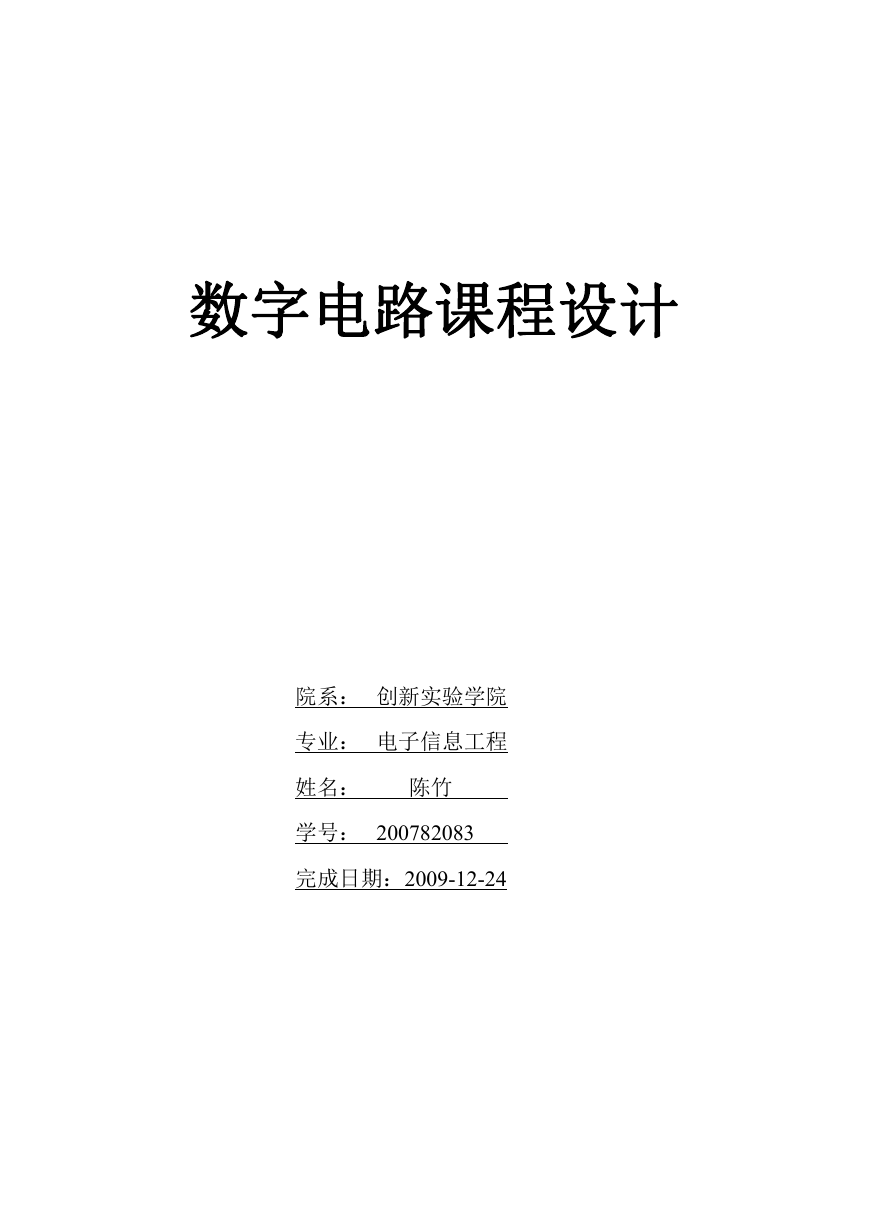
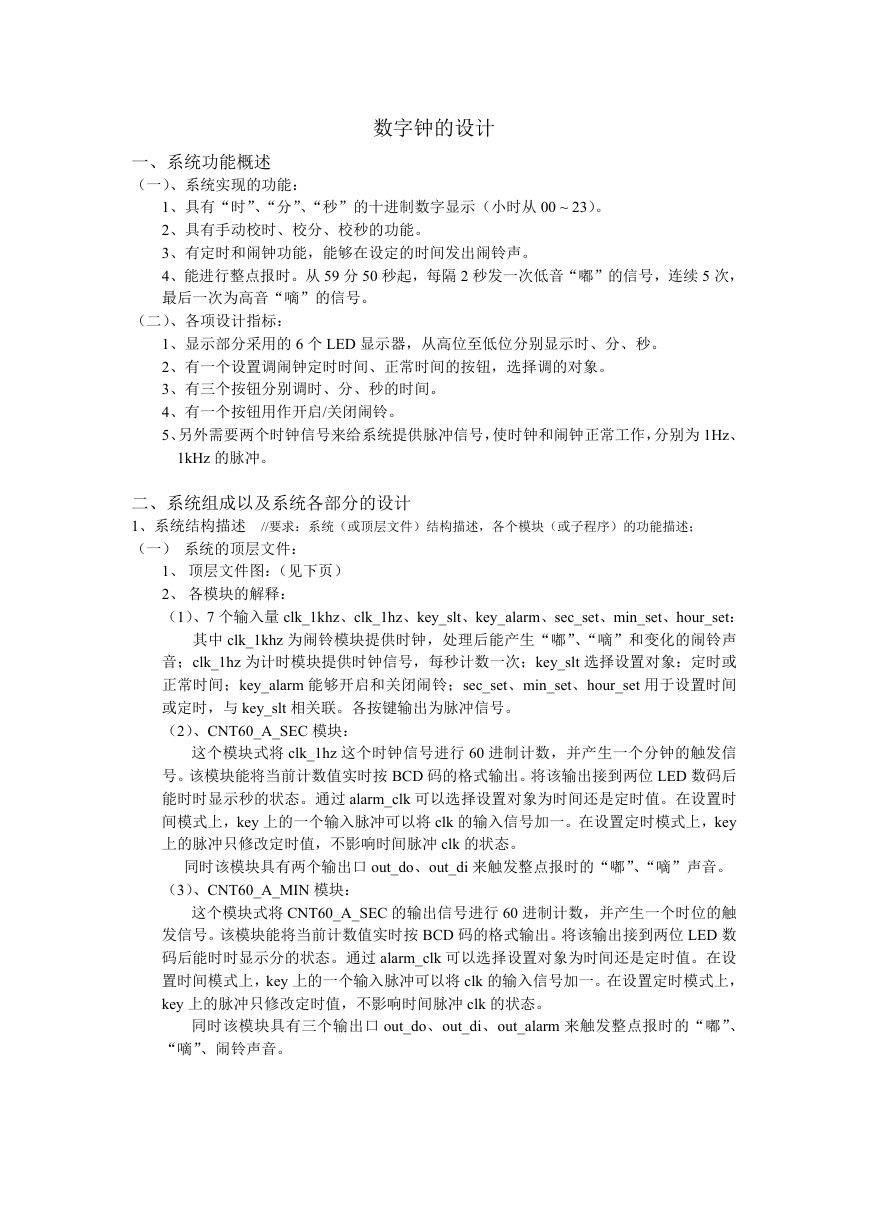
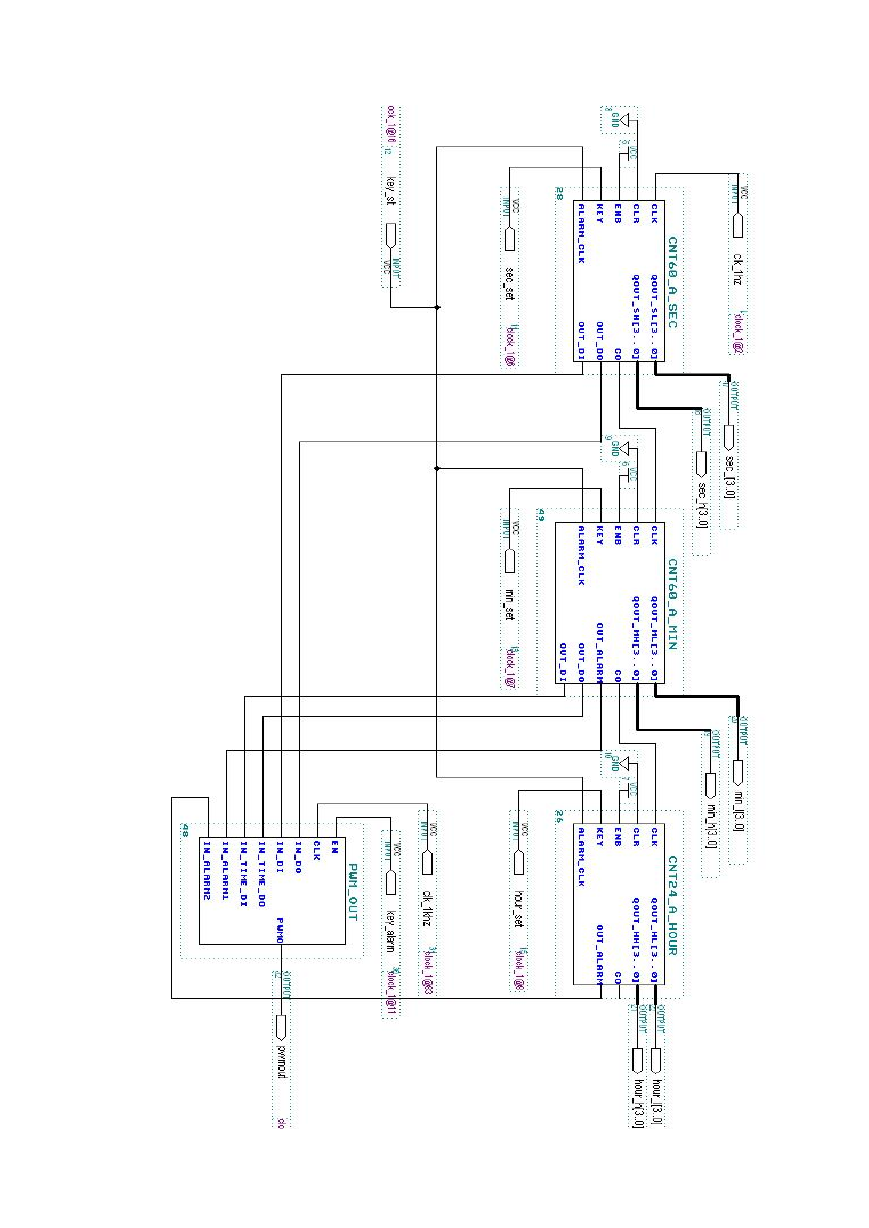

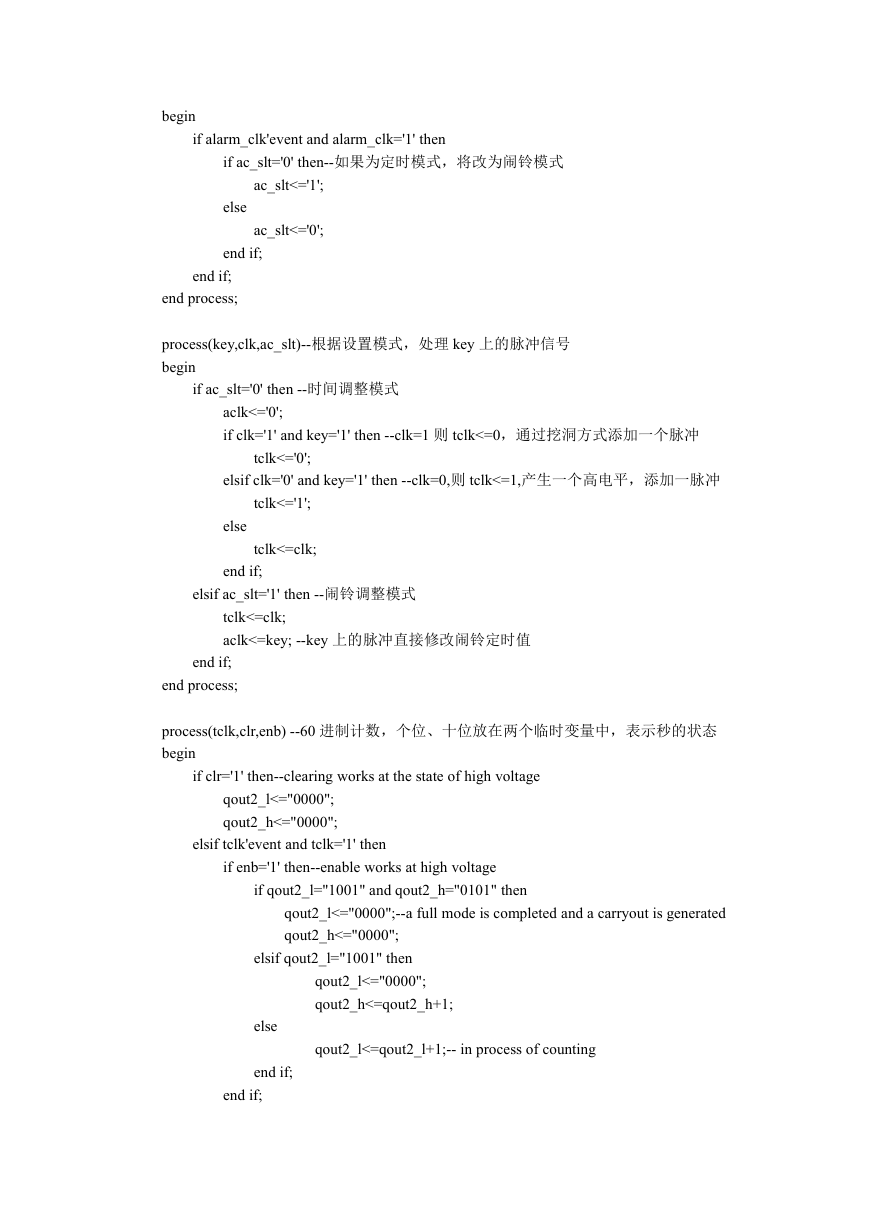

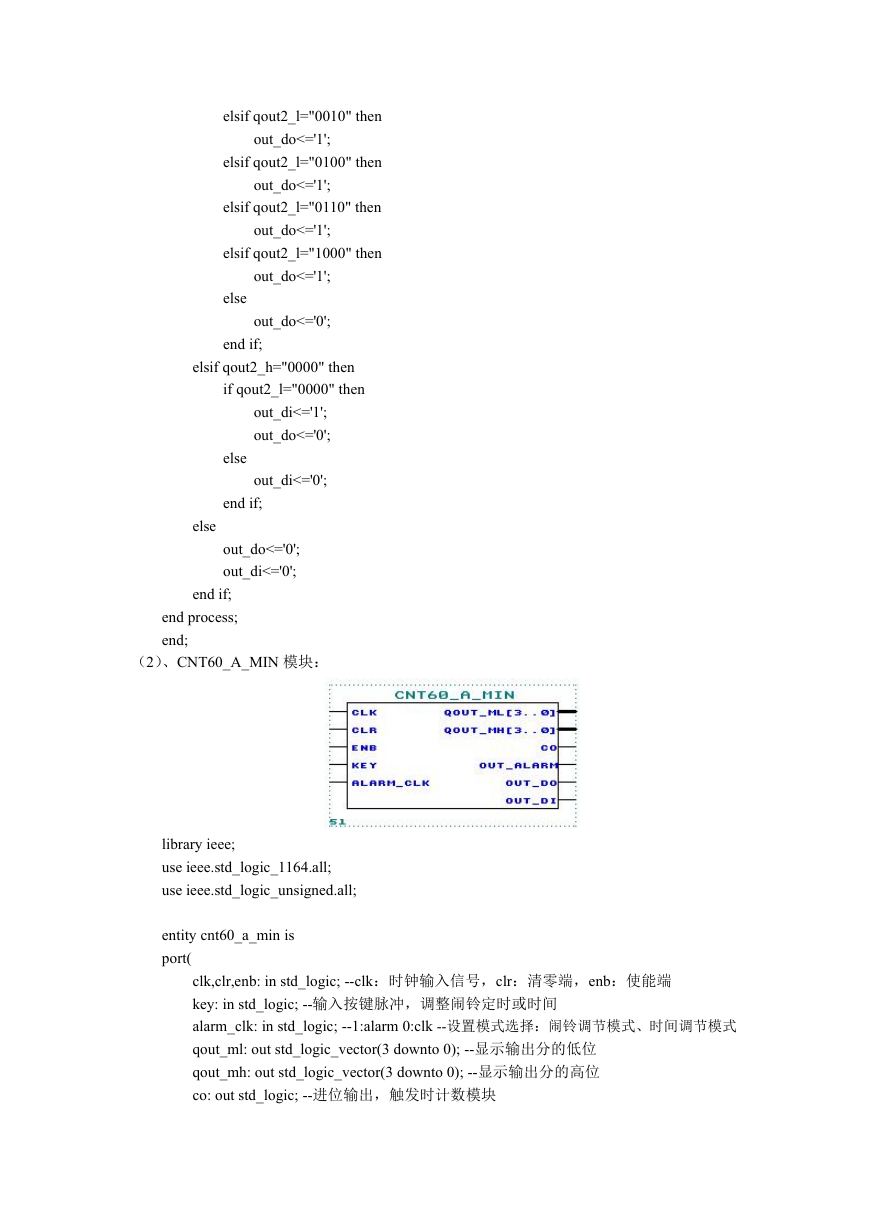
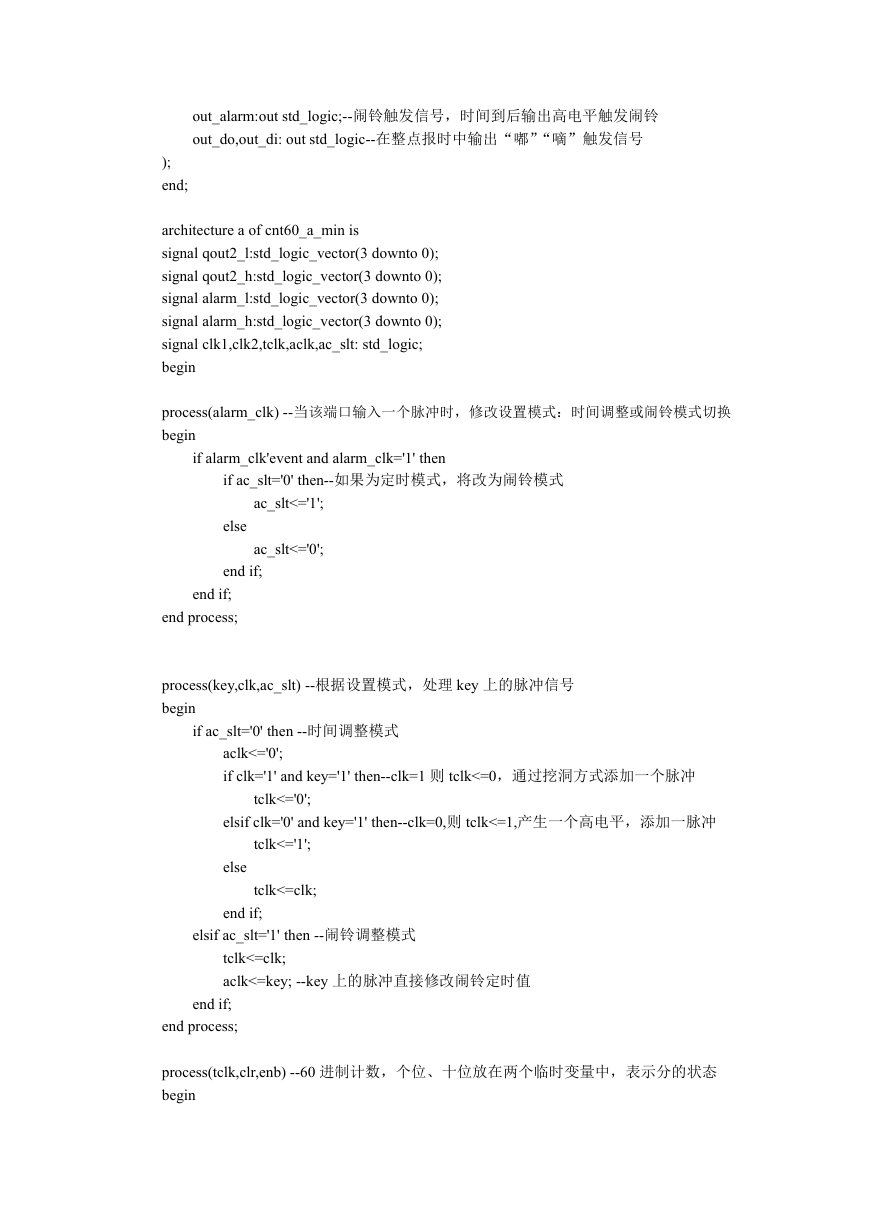








 2023年江西萍乡中考道德与法治真题及答案.doc
2023年江西萍乡中考道德与法治真题及答案.doc 2012年重庆南川中考生物真题及答案.doc
2012年重庆南川中考生物真题及答案.doc 2013年江西师范大学地理学综合及文艺理论基础考研真题.doc
2013年江西师范大学地理学综合及文艺理论基础考研真题.doc 2020年四川甘孜小升初语文真题及答案I卷.doc
2020年四川甘孜小升初语文真题及答案I卷.doc 2020年注册岩土工程师专业基础考试真题及答案.doc
2020年注册岩土工程师专业基础考试真题及答案.doc 2023-2024学年福建省厦门市九年级上学期数学月考试题及答案.doc
2023-2024学年福建省厦门市九年级上学期数学月考试题及答案.doc 2021-2022学年辽宁省沈阳市大东区九年级上学期语文期末试题及答案.doc
2021-2022学年辽宁省沈阳市大东区九年级上学期语文期末试题及答案.doc 2022-2023学年北京东城区初三第一学期物理期末试卷及答案.doc
2022-2023学年北京东城区初三第一学期物理期末试卷及答案.doc 2018上半年江西教师资格初中地理学科知识与教学能力真题及答案.doc
2018上半年江西教师资格初中地理学科知识与教学能力真题及答案.doc 2012年河北国家公务员申论考试真题及答案-省级.doc
2012年河北国家公务员申论考试真题及答案-省级.doc 2020-2021学年江苏省扬州市江都区邵樊片九年级上学期数学第一次质量检测试题及答案.doc
2020-2021学年江苏省扬州市江都区邵樊片九年级上学期数学第一次质量检测试题及答案.doc 2022下半年黑龙江教师资格证中学综合素质真题及答案.doc
2022下半年黑龙江教师资格证中学综合素质真题及答案.doc